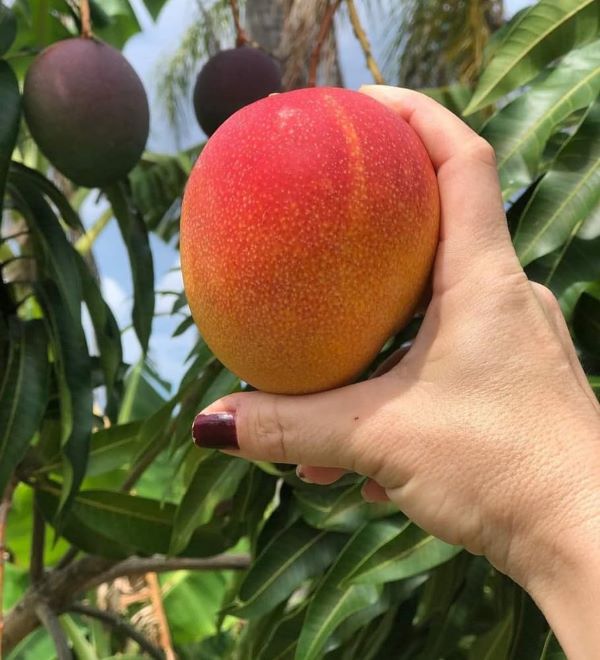Mangoes are loved worldwide, and many countries cultivate their unique varieties. These foreign mango varieties are celebrated for their distinct flavors, textures, and appearances. Here, we explore some of the most renowned foreign mango varieties, including their origins, history, where they are found, availability, and unique properties.
Contents
1. Tommy Atkins
- Origin: Florida, USA
- History: Developed in the 1920s and named after Thomas H. Atkins, who promoted this variety despite its initial rejection due to its fibrous texture.
- Found in: USA, Mexico, Brazil, Ecuador, Peru, and other tropical regions
- Availability: March to July
- Unique Property: Known for its long shelf life and resistance to disease. It has a mild, sweet flavor with a fibrous texture, making it popular for commercial distribution.
2. Kent
- Origin: Florida, USA
- History: First grown in 1945 by Leith D. Kent in Florida. It quickly gained popularity due to its exceptional taste.
- Found in: USA, Mexico, Peru, and Ecuador
- Availability: December to February and June to August
- Unique Property: Known for its sweet and rich flavor with minimal fiber. It has a smooth, juicy texture and is often considered one of the best-tasting mango varieties.
Also, read: Different Types of Mangoes in India You Need to Know Now
3. Haden
- Origin: Florida, USA
- History: The original Haden tree was planted in 1902 in Coconut Grove, Florida, by Captain John J. Haden.
- Found in: USA, Mexico, Peru, and Ecuador
- Availability: April to July
- Unique Property: Known for its bright red skin with green and yellow touches. It has a sweet, rich flavor with a slightly fibrous texture.
4. Ataulfo (Honey or Champagne)
- Origin: Mexico
- History: Named after Ataulfo Morales Gordillo, who first grew this variety in Chiapas, Mexico.
- Found in: Mexico, Ecuador, and Peru
- Availability: March to July
- Unique Property: Known for its buttery texture, intense sweetness, and lack of fibers. It has a small, flat seed and bright yellow skin.
5. Keitt
- Origin: Florida, USA
- History: First grown by Mrs. J.N. Keitt in Homestead, Florida, in the 1940s.
- Found in: USA, Mexico, and other tropical regions
- Availability: March to November
- Unique Property: Known for its large size, sweet taste, and minimal fiber. It is often consumed green in Asian cultures for its tart flavor.
6. Francis
- Origin: Haiti
- History: A popular variety from Haiti, known locally as “Madame Francis.”
- Found in: Haiti and the Caribbean
- Availability: May to July
- Unique Property: Known for its rich, spicy flavor and juicy texture. It has a bright yellow skin with green overtones.
7. Alphonse (Alphonso or Aphoos)
- Origin: India, but cultivated in many tropical regions
- History: Named after Afonso de Albuquerque, this variety has been cherished for centuries in India and has been introduced to various parts of the world.
- Found in: India, Thailand, and other tropical regions
- Availability: March to June
- Unique Property: Known for its rich, creamy texture and sweet, non-fibrous pulp. It has a unique saffron color and distinct aroma.
Also, watch web stories: What are the Best Lung Friendly Foods?
8. Palmer
- Origin: Florida, USA
- History: First grown in the 1940s and named after the Palmer family who cultivated it.
- Found in: USA, Brazil, and other tropical regions
- Availability: July to September
- Unique Property: Known for its sweet flavor and minimal fiber. It has a large size and an attractive red and green skin.
9. Irwin
- Origin: Florida, USA
- History: A result of cross-breeding in the early 20th century in Florida.
- Found in: USA, Australia, and other tropical regions
- Availability: June to September
- Unique Property: Known for its sweet taste and vibrant red skin. It has a smooth, non-fibrous texture.
10. Carabao (Manila Mango)
- Origin: Philippines
- History: Named after the native carabao buffalo in the Philippines, it has been a staple in Filipino agriculture for centuries.
- Found in: Philippines
- Availability: May to September
- Unique Property: Known for its exceptionally sweet and buttery flesh. It has a unique elongated shape and golden yellow skin.
Nutrition Chart of Foreign Mango
Mangoes are not only delicious but also packed with essential nutrients. Here’s a general nutritional profile of mangoes per 100 grams, applicable to various foreign mango varieties:
| Nutrient | Amount |
|---|---|
| Calories | 60 kcal |
| Carbohydrates | 15 g |
| Sugars | 13.7 g |
| Dietary Fiber | 1.6 g |
| Protein | 0.8 g |
| Fat | 0.4 g |
| Vitamin A | 54 µg |
| Vitamin C | 36.4 mg |
| Vitamin E | 0.9 mg |
| Vitamin K | 4.2 µg |
| Potassium | 168 mg |
| Magnesium | 10 mg |
| Phosphorus | 14 mg |
| Folate | 43 µg |
| Calcium | 11 mg |
| Iron | 0.2 mg |
| Zinc | 0.04 mg |
| Thiamine (B1) | 0.03 mg |
| Riboflavin (B2) | 0.04 mg |
| Niacin (B3) | 0.67 mg |
| Vitamin B6 | 0.12 mg |





